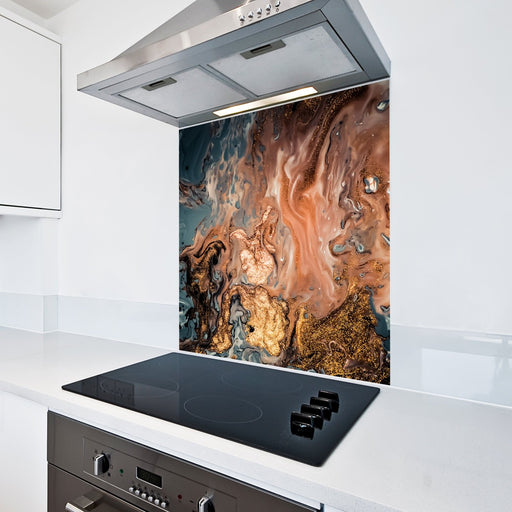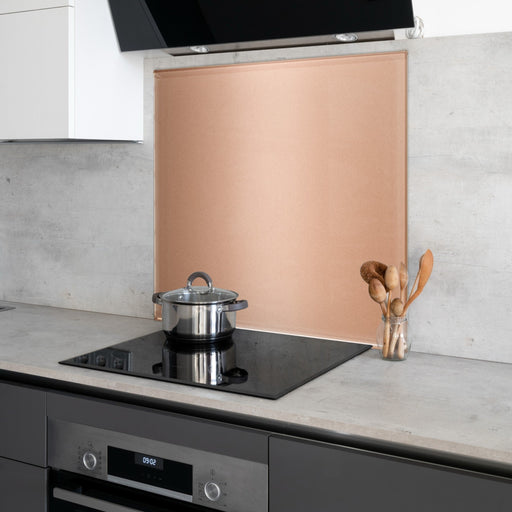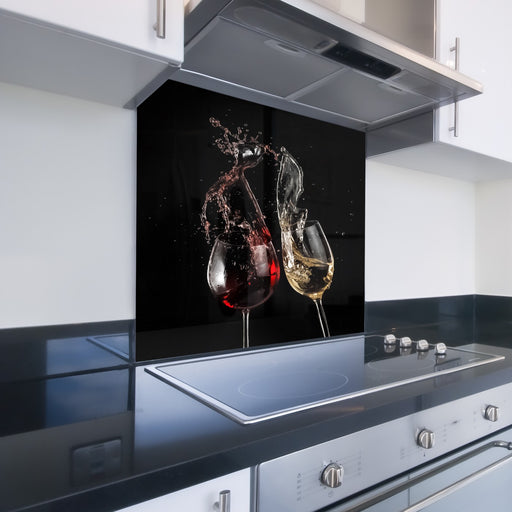Call 020 8500 1188

Glass Splashbacks vs. Traditional Tile Backsplashes: A Comprehensive Comparison
When renovating a kitchen or bathroom, choosing the right splashback is crucial for both functionality and aesthetic appeal. Glass splashbacks and traditional tile backsplashes are popular choices, each offering distinct advantages and considerations. Here, we delve into the details to help you decide which suits your space best.
What are Splashbacks?
Splashbacks serve a practical role in protecting kitchen walls from splashes and stains during cooking. They also play a significant role in the overall design of your kitchen, offering an opportunity to inject colour and style.
Glass Splashbacks
Pros:
- Ease of Cleaning: The smooth, non-porous surface of glass splashbacks makes them extremely easy to clean. Unlike tiles, glass does not have grout lines where grime and mildew can accumulate, making maintenance a breeze.
- Versatility in Design: Glass splashbacks offer an extensive range of design options. They can be customised with any colour, or printed with high-resolution images, providing limitless decorative possibilities. Whether you’re looking for a splash of vibrant colour or a subtle, elegant pattern, glass can accommodate.
- Durability: Toughened glass, used for making splashbacks, is specifically treated to increase its strength and thermal resistance. This makes it highly durable and more resistant to heat and impact compared to regular glass, ensuring it withstands the rigours of kitchen use.
- Aesthetic Effect: The reflective nature of glass enhances the overall brightness of your kitchen. It reflects light rather than absorbing it, helping to make small or dark kitchens appear brighter and more spacious.
Cons:
- Cost: Customisation and the material benefits of toughened glass can make glass splashbacks a more expensive option. The initial investment is higher, though many homeowners find the long-term benefits justify the cost.
- Installation Challenges: Installing glass splashbacks requires precision and expertise. The glass must be measured and cut precisely to fit the space, and improper installation can lead to gaps or potential breakage, necessitating professional installation services.
Traditional Tile Splashbacks
Pros:
- Cost-Effectiveness: Tiles are generally less expensive than glass splashbacks. They offer a budget-friendly solution without compromising on style, as tiles are available in a wide range of designs, colours, and textures.
- Ease of Replacement: If a tile is cracked or damaged, you can replace just the affected tile rather than the entire splashback. This makes tiles a practical choice for areas where the splashback may suffer wear and tear.
- Impact Resistance: Ceramic and porcelain tiles, commonly used for splashbacks, are tough materials that resist chipping and cracking. Their durability makes them suitable for high-traffic kitchen environments where contact with pots, pans, and other kitchen tools is frequent.
Cons:
- Maintenance of Grout: The biggest drawback of tile splashbacks is the grout. Grout lines can stain and harbour bacteria, requiring regular cleaning and sometimes special cleaning solutions to remain hygienic and visually appealing.
- Limited Design Flexibility: While tiles offer many customisation options, the nature of individual tiles limits layout flexibility. Unlike glass, which can be seamlessly fitted, tiles may not work as well for highly curved or unusually shaped areas without significant cutting and adjustment.
Both glass and tile splashbacks have their unique advantages and challenges. Your choice will depend on your specific needs, budget, and design preferences. Each option offers distinct benefits that can enhance the functionality and aesthetic of your kitchen.
Making the Right Choice for Your Kitchen
Deciding between glass and tile splashbacks hinges on several factors, including budget, maintenance preferences, and aesthetic goals. Those seeking a modern look with minimal upkeep might lean towards glass, while those prioritising budget and traditional appeal might opt for tile.
Whichever choice you make, understanding the pros and cons of each option ensures that your kitchen not only looks great but also functions effectively for years to come. If you’re still undecided or need further assistance, exploring more about glass splashbacks can provide additional insights tailored to your specific needs.
Cost Considerations
Material Costs
Before deciding whether a glass splashback or tiling is more cost-effective for your kitchen or bathroom renovation, it’s essential to conduct a detailed analysis of material costs. This includes not only the primary materials like tiles or splashback panels but also auxiliary supplies such as grout for tiles or adhesive for splashbacks. Additionally, consider the costs of any necessary accessories such as trims, silicone sealant, and tile seaming strips if you’re opting for tiling. Ensuring that all these elements are accounted for in your budget will give you a clearer picture of the total costs involved.
Labor Costs
The cost of installation is another critical factor. Tiling can be labour-intensive and often requires skilled craftsmanship due to the complexity of the work and the knowledge required for effective installation. This generally translates to higher labour costs as professional services may be necessary. On the other hand, glass splashbacks are often designed for easier and quicker installation, which might reduce the cost if you opt for a DIY installation or even if professional help is required. The simpler and faster installation process of glass splashbacks can lead to lower overall labour costs compared to tiling.
By considering both material and labour costs, you can make a more informed decision on which option is more economically viable for your specific situation, ultimately helping you achieve a balance between cost, functionality, and aesthetic appeal in your kitchen or bathroom renovation.
Maintenance Requirements
Both tiling and glass splashbacks require regular maintenance to keep them looking their best. Tiles may require more frequent cleaning due to their porous nature, which makes them more susceptible to staining and grime accumulation. They may also need periodic re-grouting to maintain their appearance and functionality. In contrast, glass splashbacks offer a more low-maintenance alternative; they are easier to clean due to their smooth, non-porous surface. However, they are not completely maintenance-free and may occasionally require repairs, particularly if they experience impact damage.
Other Considerations
Long-Term Value and Practicality
Understanding the upfront costs of your bathroom or kitchen renovation project is crucial, but considering the long-term value and practicality of your choice between tiling and glass splashbacks is equally important. Tiling can offer durability and a classic appearance that may contribute positively to the property’s value over time. On the other hand, glass splashbacks provide a modern look and can also enhance the brightness and perceived space of a kitchen or bathroom, potentially making these areas appear more attractive to future buyers.
Installation Complexity and Risks
As previously mentioned installing tiles can be labour-intensive and requires precision to avoid costly mistakes, which may lead to frustration and additional repair costs. Conversely, glass splashbacks are generally simpler to install, often requiring less time and potentially lower installation costs. However, the ease of installation can vary depending on the specifics of the project, such as the size of the area covered, and the complexity of the cuts required. It’s important to weigh the difficulty of installation against the potential risks and decide whether DIY installation is feasible or if professional installation is a safer, albeit potentially more costly, option.
Discover Glass Kitchen Splashbacks at EGW!
As we’ve explored, choosing the right kitchen splashback can dramatically enhance the functionality and aesthetics of your kitchen. At Express Glass Warehouse (EGW), we offer an extensive range of glass kitchen splashbacks that combine beauty with practicality.
Our glass solutions are tailored to meet your specific design needs and preferences. Whether you are looking for clear glass to maintain a sleek and simple look, or you wish to add a pop of colour with a painted glass splashback, we have the expertise to bring your vision to life. Our splashbacks are not only stylish but also built to last, providing a durable and easy-to-clean surface that elevates the overall look of your kitchen.
Why Choose EGW?
- Customisation: We offer bespoke glass splashbacks that fit perfectly in your kitchen space, ensuring a seamless and elegant finish.
- Quality Assurance: All our glass products are made from high-quality low-iron toughened glass, ensuring clarity, durability, and longevity.
- Expert Advice: Our team of experts is always ready to provide guidance and support, helping you make the best choice for your home.
If you’re ready to transform your kitchen, check out our collection of set sized splashbacks, find out more about bespoke splashback options, or contact us directly. Our friendly team is here to provide you with all the information you need and assist you in selecting the perfect glass splashback for your home. Discover how easy and affordable it is to refresh your kitchen with EGW today!
Products you might like
Bespoke Painted Glass Splashbacks
From6mm Toughened Printed Kitchen Glass Splashback - Luxury Abstract Marble Fluid 134
From6mm Toughened Printed Kitchen Glass Splashback. If you would like to upload your own image or request a bespoke size call our dedicated team on...
View full details6mm Toughened Printed Kitchen Glass Splashback - Copper Marble 105
FromProduct Information6mm Printed Toughened Marble Copper Glass Splashback If you would like to upload your own image or request a bespoke size call o...
View full details6mm Toughened Painted Kitchen Glass Splashback - Copper (Metallic Shimmer)
From6mm Toughened Painted Kitchen Glass Splashback. If you would like a different colour or a bespoke size call our dedicated team on 020 8500 1188 for...
View full details6mm Toughened Printed Kitchen Glass Splashback - Wine 360
From6mm Toughened Printed Kitchen Glass Splashback. If you would like to upload your own image or request a bespoke size call our dedicated team on 020...
View full details





